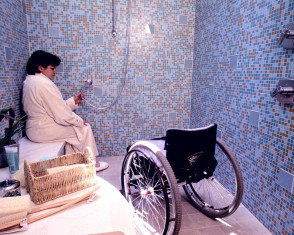Remodel Your Bathroom To Improve Accessibility And Comfort
Since most homes aren’t made with complete wheelchair accessibility in mind, it’s likely you’ll need to do some home renovations to accommodate one. Typically the first room to renovate would be the bathroom, starting with the wheelchair shower. Here are some tips on the steps you should take for absolute accessibility.
Step #1: Remove the tub or lower the curb
Many bathrooms have hybrid bathtub-showers, and these are not accessible. A wheelchair shower should allow the wheelchair to roll right in, so removing the tub will be the first step in your home renovations. If you have a wetroom, ensure the curb on the shower is low enough that wheels can easily slide over it.
Step #2: Check the door clearance
Unfortunately, most interior doorways—especially those in older homes—are not wide enough to comfortably accommodate a wheelchair getting through. Check with a home renovation expert to make sure widening the doorways won’t have any structural impact on your home. The door of a wheelchair shower will also need at least a 36” clearance.
Step #3: Add or install slip-proof flooring
If you like the pre-existing tiles in your wheelchair shower but worry about a lack of traction, there are several types of slip-proof coatings that can be applied to the floors. You can also speak with a professional about installing new flooring in your bathroom—and perhaps the rest of your house too – if you want a more complete home renovation.
Step #4: Install stability bars
This is an important step for your accessible home renovations. These bars should be installed in the wheelchair shower as well as beside the toilet. Even the smallest bathroom should have at least two stability bars to improve accessibility.
Step #5: Replace a cabinet sink with a pedestal sink
Depending on the bathroom you’re renovating, you may be able to skip this step if you already have pedestal-style sinks. However, if your sinks have cabinets or are installed into a counter, you will need to think about replacing them so a wheelchair can pull up underneath. This may not be necessary for every sink in the house, but must be done in the master bathroom at minimum.
Whenever it comes time to do your home renovations, it’s always wise to consult experts before starting anything. Even if you intend to remodel for a wheelchair shower yourself, a professional will be able to go into much greater detail for each of these steps.



